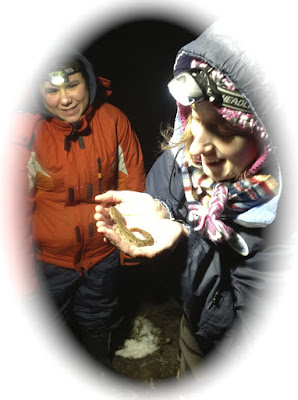Mystery Snail
Declines in abundance of Cipangopaludina chinensis (Chinese Mystery Snail)
Frederick W. Schueler & Aleta Karstad (Fragile Inheritance Natural History) and Naomi Langlois-Anderson (South Nation Conservation), background information for poster paper at the 5th Biennial Canadian Freshwater Mollusc Research Meeting, Burlington, Ontario, 15-16 November 2023.
The Chinese, or Oriental, Mystery Snails (Cipangopaludina, or Bellamya, chinensis) are remarkable because of their huge size (to 60 mm high), and uniform dark greenish coloration. Introduced to the Pacific Coast for food by oriental immigrants in the 19th Century, and to many places throughout eastern North America throughout the 20th century as an aquarium snail, these are now widespread in Ontario. There used to be lots of taxonomic discussion of the species or subspecies represented, but we haven’t tried to distinguish the different kinds (though we’ve never noticed the dimpled shell texture of the C. malleatus ‘kind’).
The species is often extremely abundant, and when dense populations were discovered in Winchester, Ontario, in 2010, South Nation Conservation undertook three years of “Snail Snagaroo” removals to try to control the populations in Henderson Creek there. A decade after the control effort ended, the observation that the snails were uncommon in one of the control sites triggered a review of apparent population changes in other sites where we’ve found the species.
The current state of this review is just based on our records, without consulting museums, colleagues, or iNaturalist. This results in 7 apparent declines, 4 sites where the population appeared stably common or abundant, 7 sites where the snails were abundant on one visit, 3 where they were sparse in one visit, and 2 sites (in and below Muskrat Lake, Renfrew County), where they appeared at places we’d previously repeatedly visited. We haven’t seen a site where the species went from scarce to abundant.
The declines we’ve noted are possibly associated with the control efforts, predation by Mammals (based on broken shells that look bitten), onset of Zebra Mussel populations, or drought, though we can’t certainly assign any of these declines to a certain cause.
The records below can be used by others to check on the status of the populations, or advise us of previous observations at the sites (send reports to <bckcdb@istar.ca>). Our plans for 2024 are to check as many of these sites as possible, and to update this report.
==================================
July 1994 – Hamilton-Wentworth Region: Highway 403/Old Guelph Road (43.28605° N 79.89627° W). 1 shell, Valley Inn Rd/Grindstone Creek (43.28983° N 79.82384° W). 4 shells, Royal Botanical Garden, Grindstone Creek trails (43.29548° N 79.87514° W). - drawing in APTW
6 September 2001 – Nipissing District: Mattawa R at Hurdman dam, 3.7 km W Mattawa. (46.31068° N 78.74849° W, HABITAT: mucky/swampy hydro impoundment of small brownwater river at dam, in White Pine/mixed forest)
17 July 2010 – moved 7.21km ENE, Moira R/Rapids Road, 6.4 km SW Actinolite. (44.50970° N 77.39079° W, HABITAT: shallow clear lake-outlet rocky river, deciduous woods) 1 mature shell picked up. - https://karstaddailypaintings.blogspot.com/2010/07/moira-river-phoebe.html
19 August 2011 – Winchester: Henderson Creek above Gypsy Lane. (45.08178° N 75.35174° W, HABITAT: clay drainage ditch between disturbed-ground oldfield & cornfield). 348 taken in control effort, mean=29.85 mm (8.20 - 49.20) st.dev.=9.24 mm. https://karstaddailypaintings.blogspot.com/2011/08/chinese-mystery-snail-habitat-oil-on.html
19 September 2016 – York Region: Scarborough: Rouge Park, Ressor Road pond. (43.82799° N 79.18960° W, HABITAT: soupy green residual water in cracked-mud drained pond). Fifty-to-seventy/square metre is not uncommon here - 3/square metre a minimum estimate for the whole pond - dead ones on higher areas and not-yet-dead ones in a few lower areas of the basin - some broken shells but no signs of predators crunching them up, or Procyon lotor (Raccoon) tracks in the mud.
29 July 2019 – moved 668m S – Highway 31/Hess Creek (45.03852° N 75.29907° W), common adults, scattered on branches in clear water near culvert.




Comments
Post a Comment